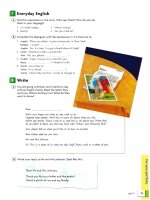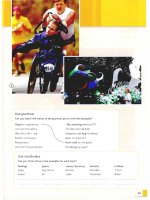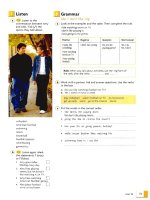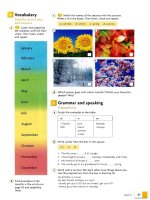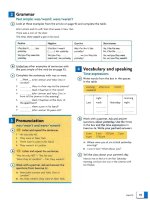Aviation english students book
Bạn đang xem bản rút gọn của tài liệu. Xem và tải ngay bản đầy đủ của tài liệu tại đây (15.22 MB, 130 trang )
oF Aviation
ae
& Aviation
ENGLISH
For ICAO compliance
Henry
Emery
with Ruth Goodman
& Andy
Roberts
and Louis Harrison
MACMILLAN
INTRODUCTION
This course is for aviation professionals ~ particularly pilots and
air-traffic controllers ~ who wish to reach and maintain level 4
(operational) as measured by the ICAO Language Profile descriptors
(see pages vi and vii). The course aims to increase confidence in
communication and develops the very specific skills described in the
ICAO level 4 language profile. These are the skills needed to succeed
in any Level 4 assessment and also to function effectively and safely
in an aviation environment
This course does not aim to teach the phraseology that aviation
professionals need but it is included to provide a context for the plain
English needed for communication between pilots and air-tratfic
controllers, and between pilots and pilots. The main focus is on the
language needed to communicate in non-routine and / or emergency
situations during flight operations.
The Student's Book contains the material for the course in the form of
reading and listening texts. The main purpose of this is to present new
vocabulary and to provide a context for the exercises and language
functions. There are lots of pair-work and group-work activities for
speaking practice for the benefit of students using the course in a
classroom situation.
The course is intended both for independent study and for classroom
use. The CD-ROM supports the student's book with interactive language
and pronunciation exercises, simulations
Participate,
in which the student can
and all the audio files from the Student's Book.
The Teacher's
Book contains extra support and ideas that can be used to supplement
the material contained in this Student's Book.
| 1NTR0bUCT10N
Each of the 12 units in the Student's Book is divided into four two-page sections.
Section 1
is based on a reading text and provides an introduction to the main theme
of the unit,
Section
2
is based on a listening text or texts and provides sustained listening and
pronunciation practice work
Section 3
is based on an emergency or non-routine flight operation scenario. It always
contains a listening text or texts involving a radio telephony exchange with a
mixture of phraseology and plain English
Section
4
is an extension section which includes further practice,
extension of language taught within the unit
consolidation and
The interactive CD-ROM complements the material in the Student's Book by
providing interactive simulations, detailed pronunciation and extra listening,
The CD-ROM material is split into 12 units which match those of the Student's
Book. It has two sections.
Section
1
Section
2
contains further practice on pronunciation and listening,
contains animated interactive sequences in which students are encouraged
to.use the language taught in the corresponding unit of the book. Students
can compare their own speech with model responses and take the role of
characters in the animation.
We hope that you enjoy using Aviation English.
Henry
Andy
Emery
Roberts
RUNWAY
°
UNIT 2
chảo
Reading and vocabulary
Explaining abbreviations
Listening and speaking
twit
Page 24
Describing actions
and position
Listening and speakin
L0ST
TECHNOLOGY
Listening and speaking
2
0
ANIMALS
Page 32
‘
to
it
mm
F
Reding and vocabulary
Expressing purpose
Listening and speaking
Saying tings
nother way
Listening and speaking
Expressing preferences;
Explaining unknown
words
”
‘
emus
mm
GRAVITY
Page 40
Reading and vocabulary
Listening and speaking
°
UNIT 6
HEALTH)
Page 48
Ustening and speaking
Reading and vocabulary
ening and speaking
Listening and speaking
Pairwork, pages 104-112 Recordings, pages 113-128.
iv
Explaining how
something works
‘Comparing and
contrasting
Expressing dificult
‘and offering help
Expressing cause
and elect
Making suggestions
and giving advice
Giving and asking
for updates
°
obatics
"
n
Obligation, prohibition
and permission
Orders and requests,
FIRE
kó
Identifying and
fesponding to problems
METEOROLOGY
Page 64
Listening and speaking
LANDINGS
Page 72
Listening and speaking
ee
Changing the strength
of adjectives
Results and consequences:
Repeating information
Describing sensory
impressions
Daseribing 3-D position
‘and moverent
Resolving
misunderstanding
‘Suggesting solutions
to problems
FUEL
hae
PRESSURE
Page 88
Listening and speaking
Expressing time and
duration
Summarizing
il
Expressing
SECURITY
Listening and speaking
Painwork, pages 104-112 Recordings, pages 113-128,
Expressing possibilty
‘and probability
Reporting
Pronunciation, sess, rhythm,
and intonation, though possibly
influenced by the first language
or regional variation, almost
never interfere with ease of
understanding,
Vocabulary range and accuracy
are sutficient to communicate
effectively on a wide variety of
familiar and unfamiliar topics.
Vocabulary is idiomatic, nuanced,
and sensitive to register.
Pronunciation, stress, shythm,
and intonation, though influenced
by the first language or regional
variation, rarely interfere with ease
of understanding,
Basic grammatical structures and
‘sentence patterns are consistently
well controlled. Complex
structures are attempted but with
‘errors which sometimes interfere
with meaning,
Vocabulary range and accuracy are
sufficient to communicate effectively
‘on common, concrete, and workrelated topics. Paraphrases
consistently and successiully
Vocabulary is sometimes idiomatic.
Pronunciation, stress, rhythm,
and intonation are influenced.
by the first language or regional
variation and frequently interfere
with ease of understanding,
Basic grammatical structures and
‘sentence patterns associated
with predictable situations are
not always well controlled. Errors:
frequently interfere with meaning.
Vocabulary range and accuracy are
often sufficient to communicate on
‘common, concrete, or work-related
topics but range is limited and the
word choice often inappropriate,
Is often unable to paraphrase
successfully when lacking vocabulary.
Pronunciation, stress, rhythm, and.
intonation are heavily influenced
by the first language or regional
variation and usually interfere with
‘ease of understanding,
Shows only limited control of afew
_-simple memorized grammatical
structures and sentence patterns.
Limited vocabulary range consisting
only of isolated words and
memorized phrases.
Performs at a level below the
Performs
at a level below the
Performs at a level below the
Elementary level.
vi
Both basic and complex
‘grammatical structures
“and sentence pattems are.
consistently well controlled.
Elementary level.
Elementary level,
Able to speak at length with a natural,
effortiess flow. Varies speech flow
{or stylistic effect, e.g, to emphasize
a point, Uses appropriate discourse
‘markers and connectors spontaneously
Comprehension is consistently
accurate in nearly all contexts and
includes comprehension of linguistic
and cultural subtleties.
Interacts with ease in nearly all
situations. Is sensitive to verbal and
non-verbal cues, and responds to
them appropriately
Able to speak at length with relative
ease on familiar topics, but may not
vary speech flow as a stylistic device.
Can make use of appropriate discourse
markers or connectors.
‘Comprehension is accurate on common,
concrete, and work-related topics and
mostly accurate when the speaker is
confronted with a linguistic or situational
‘complication or an unexpected turn of
events. Is able to comprehend a range
of speech varieties (dialect and / or
accent) or registers,
Responses are immediate,
appropriate, and informative.
Manages the speaker /listener
relationship effectively
Produces stretches of language,
‘but phrasing and pausing are often
inappropriate, Hesitations or slowness
in language processing may prevent
effective communication. Fillers are
sometimes distracting.
Comprehension is often accurate on
‘common, concrete, and work related
topics when the accent or variety
Used is sufficiently intelligible for an
international community of users.
May fail to understand a linguistic or
situational turn of events,
Responses are sometimes
immediate, appropriate, and
informative. Can initiate and maintain
‘exchanges with reasonable ease
on familiar topics and in predictable
situations. Generally inadequate
when dealing with an unexpected
tum of events.
Can produce very shor, isolated,
‘memorized utterances with frequent
pausing and a distracting use of
fillers to search for expressions and to
articulate less familiar words.
‘Comprehension is limited to isolated,
memorized phrases when they are
carefully and slowly articulated.
Response time is slow, and often,
inappropriate. Interaction is limited to.
simple routine exchanges,
Performs at a level below the:
Elementary level
Performs at a level below the
Elementary level
Performs at a level below the
Elementary level
vii
TNCURSTON.
Section
one
— Avoiding
miscommunication
1 Work in pairs. Discuss the questions below. Ask each other questions to get more details.
1. Have you ever worked with someone whose English you didn't understand?
2 What are some of the causes of miscommunication between controllers and pilots? Note down your ideas,
2. Read the article about a report rom a National Aviation Safety Investigation on tower-pilot communications.
Check which of your ideas from activity 1 are included.
‘Arecent report showed that
miscommunication isa factor in over 70%
‘of operational erors. The report examined
example, when analysed, contains eight
‘separate pieces of information, or eight
opportunities fr miscommunication:
1. Requests from the pilot that the
controller repeat the instructions
2 Misunderstandings
by the pilot that
‘esult in incorrect readbacks
3 Failure of the controller
to recognize
Wncorrect readbacks
4 Either the controller
or the plot
confusing
the call sign
‘Several factors increased
the possibilty
‘of communication breakdown. The most
Domier inbound, then taxi runway 32 lft,
intersection departure at Gul, va outer,
four areas of miscommunication:
‘important was the complexity of the
Instructions. The following instruction, for
B | RUNWAY
INCURSION
3890, Ground, give way to the second
Charlie, Gulf.
Alack
of fluency in English can
‘cause confusion both because of
mmispronunciation and misunderstanding.
But too much fluency in Engish can aso be
‘a dangerous thing! Any idiomatic language
‘or inappropriate plain English can cause
mmisunderstandings. Also, instructions
‘spoken too quickly can be very dificultto
Understand.
The report made the following
recommendations for further impravements
in ATC communications:
* Keep instructions short
* Listen to whata pilot reads back
* Speak slowly
¬
* When talking to pilots / controllers
‘who don’t speak native English,
break
up the message into its individual
‘words by using short pauses
‘+ Ask when not sure about
a piece of
information * Include the full callsign when giving
an instruction or reading back
‘= Wait
for complete aircraft
identification folowing instructions
3
Underline the correct information
1 In the frst incident, the maintenance truck driver
misheard
/ misunderstood the controller.
2 Inthe second incident, the captain misheard/
misunderstood the controller.
3 Inthe third incident, the pilot /the controller
/ both
the pilot and the controller misunderstood the
other person.
4. 30% of operational errors involve /do not involve
miscommunication,
5 The main cause of misunderstanding is instructions
that are unclear/ very complicated.
6 The safest way to communicate is using simple
English / natura, fluent English.
4 Work in pairs, Discuss the questions,
1 What additional recommendation would you add to
the reports?
2 How could each of the three incidents described at,
the start of the article be avoided?
3 Do you know of any incidents where
miscommunication has caused a runway incursion?
Vocabulary - Communication
‘Try to remember what verbs are used before the following
‘nouns in the article. Then look back at the text to check.
1m
a request
2+
clearance
3g
‘a response
an
amessage
Sử
amistake
er
an instruction
To
call sign
8g
an instruction
Functional English — Asking for
information
1 Use the verbs in the box to complete the questions
from an Aviation Authority survey.
does have must do will did are
Survey
1
When
you start
to learn English?
2 How long
3 How
outside class?
you been
studying English?
you try to improve
your English
4. What language training
5 What
English?
you find most difficult about
6 How often
you use English in your work?
7 How much support
give you?
8 Why
you had already?
your employer
‘you studying English?
9 What level of English
10 What level of English
your job?
you be happy with?
you have tor
2 Workin pais. Interview each other using the questionnaire
Speaking — English in aviation
Work in small groups. How far do you agree or disagree
With the statements below? Why / Why not?
1. AFtench ATC speaking to a French pilot at a French
aitport doesn't need to know English,
2 Its impossible to understand Americans — they don't
speak plain English.
3 Pilots have been flying safely for years ~ they don't
need to learn English.
4 R/T phraseology is enough to communicate with,
5 All pilots and ATCs working with international traftic
should have ICAO level 5.
RUNWAY INCURSION
9
a
Section
i
two
-
Airport
Layout
1. Work in pairs. You are going to complete a map of JFK.
Airport. StudentA look at the map on this page. Student B
look at the map on p 107. Don't look at each other's maps.
‘Student A
Find out from Student B where the following
buildings and features are. Mark them on your map.
‘= the airport administration offices
© customs offices
* the national weather service
‘+ the postal service offices,
+ ahelpad
Describe the position of the buildings and features
that Student B asks for. The prepositions in the box
will be useful
Ín the centre of in frant of next to behind
opposite tothe northof parallel to
con the opposite side of
~
2.
01,02,03 Listen to an ATC describing three
‘hotspots’ at JFK. Which three areas (A-E) on the
‘diagram in 1 does she mention?
3.
01,02,09 Listen again and match each problem
with one of the areas in activity 2.
1
2
3
4
Outbound aircraft can easily cross a
runway if they miss the taxiway.
You can't see the runway you are taxiing to
Inbound traffic must tum right to avoid conflict,
You can have a long taxiif you turn left
t00 soon,
5. You can easily follow the wrong line
4 Describe an airport you know, including the tax
routs for arving and departing tatfic. Are there any
hotspots?
Pronunciation —-The ICAO alphabet
1 ® 04 Listen and write the letters in the correct column
in the table according to their stress pattern, The first one.
thas been done for you.
oRZNHJISA
00
a
00
00
o0o,
2 ® 04 Listen again and repeat,
3. Work in pairs. Add the missing letters of the ICAO
alphabet to the table.
4. Spell the following items for your partner to write down,
'* the town where you were born
‘your full name
= your address
10
RUNWAY INCURSION
Vocabulary — Prepositions
Below is a controller's report of an incident in area C of the aerodrome,
Complete the report with the missing prepositions.
to at ahead on towards into onto across from via _ along
Controller's report
(QE433 landed (1)
runway 22R in marginal
weather conditions. The crew were issued
instructions to taxi (2)
the runway (3)
the apron on K and B (4)
KA. They taxied
6)
K, but missed the sign and the runway
holding position markings for 13R, and went
6)
the active runway and (7)
KA
on the opposite side. At the same time, a 747
was taxiing (8)
position on runway 13R.
6)
the intersection with B, the crew missed
the arrow pointing right. It continued straight
(10)
and taxied (11)
the terminal
on A. QE433 finally came nose-to-nose with the
‘outbound 747
Speaking — Sketching out an airport
1 Work in pairs. Look at the aerodrome information. Design an aerodrome layout including runway and taxiway
configuration and the taxi circuit. Mark these positions on your diagram:
‘+ Where ATC issue runway-in-use information and taxi clearances
The holding positions) in case of traffic conflict
Where ATC issue take-off clearance
Where ATC issue clearance to taxi to apron
Where ATC issue parking information
J
Compare your ideas with another pair.
Prevailing wind:
Type of traffic:
IFR
and International
scheduled, domestc
Average daily tratfic movements: 1,100
RUNWAY.
.1NC
2. @ 05 Listen to a dialogue between a tower controller
and a pilot, Underline the correct word to complete the.
‘summary of the incident,
In margi
/ goodnal
weather conditions, an inbound
outbound aircratt takes the incorrect taxiway and
‘moves onto an active /inactive runway. Another
aircraft lands / takes offn tront of the aircraft. The.
tower controller tells the crew to turn left/ stop, In the
‘end the plane follows
/ clears the runway.
3 © 05 Listen again and mark on the diagram:
1. The route the tower controller expects the plane to
take.
2 The route the plane actually takes.
3 The position where the plane stops to wait for,
further instructions.
4 The position where the tower thinks the plane has
stopped to wait for further instructions,
Pronunciation — Numbers
1. © 06 Listen to the cal signs. Correct any mistakes.
+ FR9e9 396
AQ692
CZ310.
LN488.
HY557
JM402
2. Work in pairs. Practise saying call signs.
Student A, go to p 104, Student B, go to p 107.
Vocabulary ~ Verbs describing
actions and position
Put these ground manoeuvres in the correct column
according to their speed in routine operations.
stond movearound approach tum push back
head
wait rollfortake-off taxi queue
touch down exit face
no movement
stand
12
RUNWAY INCURSION
slow
move around
fast
Functional English — Descri
ing actions and posi
Look at these extracts from the dialogue.
1'm facing Kilo.
We are approaching Charlie on Kilo.
There's somebody taking oft!
There are signs showing the runways.
Complete the description of the picture with the verbs from the Vocabulary section in the correct form,
1 There's a 767-300 touching down on runway 27R..
2 An A330 isturning left.
3 It____
the far end of the same runway.
4
two aircraft —— towards the apron.
5 ASaab 340
south. It____
to cross.
runway 27L.
6 Onrunway27LaB777-300_
lorake-off,
7 An Embraer ERJ-145
into position.
8 Alter the Embraer,
three more aircraft
to depart on runway 27L.
9 A few service vehicles ___ around on the
apron.
10 Seven aircraft__at the gates.
11 Atruck —
a747-400.
12 AnIL-96
its gate.
Speaking
1 Work in pairs to complete your pictures
of an airfield. StudentA look at this page. StudentB go to p 107.
2. Work in pairs, Discuss the questions.
1 What factors increase the possibilty of hotspots?
2 What can be done to reduce hotspots?
3 Are hotspots becoming more or less of a problem?
4 Which airports have the most / fewest hotspots?
RUNWAY INCURSION | 13
So
Section
four
—
Language
development
Functional English — Question forms
1. Rearrange the words to make questions.
1 you / aviation / start / career / your / when / did / in?
2 of aspect / your / do / most / you / job / enjoy / what?
3 have / which / worked / you / at / airports?
4 hours / week / average / how / on / work/ many /a/ you / usually / do?
5 you /Gid / problem /in / experience / when ast / English / communication / a?
6 how /10/do / training / often / have / you / attend / courses?
7. language / much / will / training / have / you / year / this / how?
8 long / did / how/ to/ your / do / job / train / you?
2. Answer the questions using full sentences,
Example
I started my career in aviation five years ago.
Describing actions and position
3 Look at the diagram and complete the description
1
2
3
4
5
6
7
8
9
14
RUNWAY INCURSION
of what the planes mentioned are doing
RUIZ
its gate.
CAI93
the apron
an aircraft
on runway 27R.
two aircraft
at the gates.
ELAG7
runway 27L.
The Asso
position.
Three aircraft
for take-off on runway 27R,
QE433
an intersection
Anaircraft
A
4 Read this report of the incident shown in 3. Complete it with the words from the box.
came nose-to-nose continued straight ahead taxied along landed on taxi from
cartied
on towards taxiing into went across
Incident report
QE433 (1)
=
instructions to (2)
the runway
to the apron on C and
A via H. It (3)
crew missed
C, but at the intersection with H, the
the arrow pointing left, and (4)
and (5)
the active runway and
was (6)
. They then missed the sign for runway 09L,
onto B
on the opposite side. At the same time, an A330
position on runway 27R. QE433 (7)
(8)
with an outbound 747 on B.
—
_
the terminal and
Vocabulary — Communication
1
Complete each sentence with a verb related to:
correct form.
1
When the pilot r__
the instruction, | realiz
mà
mẹ
2 Oonrolers should k
their instructions
3 Hold short of the runway and w_—
for fur
4 Pilots can m
complex instructions, $01
‘them up.
8. The truck driver thought the tower had i
cross the runway.
6 Whenr
i
8
toan ATC traffic call-out, the pilot should
his call sign.
Ia controller m
Ifapilotg—
instruction.
2 Word, the pilot may not understand,
__ an ineorrect readback,r_
the
Parts of an airport
2. Rearrange these letters to make features of an airport.
1
2
3
4
5
tootpsh
awaxity
worar
stabl cenef
naggise
6 menavept krimsang
7 nittercoseni
8 altremin
a point in an airport where there is danger of runway incursions
‘road that planes take to get to and from the runway
aa symbol that shows you which way to go
a barrier that protects an area from the force of jet engines
letters, numbers and symbols that are positioned around an aiport
to show pilots where they are and which way to go
ines and letters painted on the ground
a place where two runways, roads, etc. cross
the main building at an airport
RUNWAY
—
INCURSION | 15
a
5
`... ...
ight across
an ocean?
Match the words below with the definitions af,
calculate track fix endurance chat compass destination en route
the longest time an aircraft is able to fly without stopping
a map used for planning and marking a route
on the way; on the line that your journey follows
a piece of equipment that shows your direction
the line on a map that an aircraft follows
the place you are travelling to
a position in space, usually on a flight plan
to use mathematics to find out something
3. Read the text about the flight on the opposite page. Label the pilot's route on the map.
16
L0ST
*
4 Complete the pilot's fight pian.
5 Read the text again and answer the questions.
pilot
1
2W
Flight plan
a”
‘ARCRAFT
work
SKS ORL
aktand, California
Australia
1
uciroesrnanon
#ERSoNSOMBOMĐ
‘miourance
bà
EetuurroruUotTME (3)
chusnggŒo
9)
TiEOEDEPARTURE
Solo flight to
(6)
FROM PAGO PAGO
Norfolk Island
wv
In 1978, pilot Jay E. Prochnow
asa long and dangerous mission, | _ He planned his fight well. He
was working for an aircraft sales
‘Aftera stopoverin Hawaii,
departed Pago Pago at 0300, and,
company in Oakland, California. | he completed the second leg of
_|_with 15 hours of daylight in front
‘An experienced civil and military | the journey on schedule, and
of him, he could make visual
pilot, Prochnow
was given the
arrived on the Samoan
island of | contact
with the fixes and his
task of delivering a Cessna 188
Pago Pago without incident. The | destination below him.
single-handed from Oakland,
pilot rested for one day before he
Using the NDBs, Prochnow
to Australia. Because
the flight
began the third leg ofthe trip, and | navigated successfully
to the fix of
‘covered thousands of miles over
|e spent his time on the island
the island of Ono-I-Lau, almost
‘open ocean, the aircraft was
preparing for the long and tiring | directly en route. Now his task
fitted with extra fuel tanks forthe | flight ahead. The charts showed | wastofythe remaining 850 1m
journey. Apart from charts and
‘adistance of almost 1,500 nm to —_| of empty ocean to Norfolk Island
compass, the only navigation
Norfolk Island. Prochnow
\with no navigation aids at all
equipment
he had was.an ADF —_|_ calculated
a flying time of 15
Now he flew by compass alone.
-
for picking up the HF signals of
NDBs scattered across the tiny
islands of the Pacific Ocean. At
hours minimum, c
ingat 110kt_ | A few hours later he came into
in good VER conditions with a
light wind. He decided to carry
the time, this crossing
was along | maximum fuel and he filled
the
trip even for big jets. Fora single- | tanks to give
a total endurance of
engine aircraft with one crew, this | 22 hours.
6
7
Work
in pairs.
Whi
range of the Norfolk NDB, and he
followed the heading indicatedby
the ADE. As he approached
the
| ETA he looked carefully for the
island, but it wasn't in sight.
a
OU think of for pilots planning to fly long-distance in a light aircraft?
‘Make a lst, Then compare with the other pairs.
Functional English — Explaining abbreviations
1 Here are some common expressions for asking or saying what abbreviations mean.
Do you know what these abbreviations stand for?
What does NDB stand for? —_ It stands for
What does ADF mean?
lt means.
What is VFR short for?
It's short for
———
-
——=
2 Work in pairs. You are going to practise saying and explaining abbreviations,
Student A go to p 104. Student B go to p 107.
Section
tưwo
HT.
co
TH]
-
Finding
FLight
1 Look at the pictures of what happened next in the
Prochnow story. Put them in the correct order.
1—
#_
8_
4
Listen and check your answers.
3 tàu
Listen again and circle the correct answer.
1 Prochnow contacted
a other aircratt in the area
b. Auckland ATC for help.
2 Acommercial
jet made
a radio contact
b_ visual contact.
3. Both aircratt flew towards the sun to establish their
a. heading
b_ position
4. Captain Vette tried to establish Prochnow's exact
position using Prochnow's
a radio signal
b_ transponder.
5. They established the co-ordinates for
a Prochnow
Norfolk Istand,
18
Lost
N45AC
Listen again and complete the co-ordinates,
Vette
‘Turn towards the sun and report your
heading,
Prochnow Wilco. My heading is (1)
Vette
NN45AC. Sunset on Norfolk Island is 0730
zulu. That means you are (2)
and (3)
of Norfolk Island,
Vette
Your co-ordinates are (4)
You are (5)
from Norfolk island
* 10 Listen and repeat these directions and
co-ordinates.
north south east west south-east
north-west south-west north-east
274° 56°
170° 21
14°3240.25'N
‘Work in pairs. Student A look at the next page,
‘Student B look at p 108.
‘Student A Ask student B what places are at the following co-ordinates.
Write the names
of the places in the approximate position on your map.
1 31084428, - 17052107E
2 14160218 — 170423981E
Example
3 203859266 - 178*420004E
4 3696623436 - 17494616/27E
What do you have at three-one degrees, three minutes, four-four decimal two-eight seconds south,
‘one-seven-zero degrees, two-one minutes, seven seconds east?
Phar:
=-LƑT]
dM
`
7
S|]
.jLLT]Ị
fe
he
aes
alee
~
BỊ
ap
§
j
a
a
Pronunciation — Regular past tense
endings
1. @ 11 Regular verbs in the past tense have three
different sounds at the end of the verb. Listen and.
notice the verb endings.
JA We received news of your situation.
Nl The ADF stopped working correctly.
‘il/__ I wanted to have enough light to see my fixes.
2 Put the verbs into groups according to the sound of
their ending.
contacted departed established tried
followad tasked arrived approached
1/8
2 0U
3 hdl
calculated
3. @ 12 Nowlisten and repeat.
4 Work
in pairs. Use words on the right to help you tell
the story of Prochnow’s fight. Student A, tell the first
ppart of the story. Student B, tell the second part of the
story, Use the past tense.
Lost
|
19




